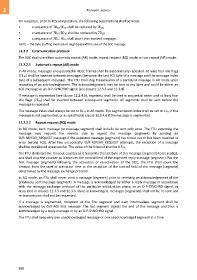Page 900 - 5G Basics - Core Network Aspects
P. 900
2 Transport aspects
On reception, prior to FCS computation, the following substitutions shall be made:
• a sequence of 7D16 5E16 shall be replaced by 7E16;
• a sequence of 7D16 5D16 shall be replaced by 7D16;
• a sequence of 7D16 7E16 shall abort the received message.
NOTE – The byte stuffing mechanism might expand the size of the SOC message.
12.2.2 Communication protocol
The SOC shall use either automatic repeat (AR) mode, repeat request (RQ) mode or non-repeat (NR) mode.
12.2.2.1 Automatic repeat (AR) mode
In AR mode, messages encapsulated in HDLC frames shall be automatically repeated. At least four idle flags
(7E16) shall be inserted between messages (between the last FCS byte of a message and the message index
byte of a subsequent message). The FTU shall stop transmission of a particular message in AR mode upon
reception of an acknowledgement. The acknowledgement may be sent at any time and could be either an
SOC message or an O-P-SYNCHRO signal (see clauses 12.3.3 and 12.3.4).
If message is segmented (see clause 12.2.4.6), segments shall be sent in sequential order and at least four
idle flags (7E16) shall be inserted between subsequent segments. All segments shall be sent before the
message is repeated.
The message index shall always be set to 0116 in AR mode. The segmentation index shall be set to 1116 if the
message is not segmented, or as specified in clause 12.2.4.6 if the message is segmented.
12.2.2.2 Repeat request (RQ) mode
In RQ mode, each message (or message segment) shall initially be sent only once. The FTU expecting the
message may request the remote side to repeat the message (segment) by sending an
O/R-REPEAT_REQUEST message if the expected message (segment) has timed out or has been received in
error (wrong FCS). After two unsuccessful O/R-REPEAT_REQUEST attempts, the reception of a message
shall be considered unsuccessful. The value of the timeout shall be 0.5 s.
The FTU shall start the timeout counter as it transmits the last byte of the message (segment) to be replied,
and shall stop the counter as it receives the control field of the expected reply-message (segment). For the
first message (segment) following the activation or re-activation of the SOC, the FTU shall count the
timeout from the start of activation time to the reception of the control field of the message (segment)
determined by the message exchange protocol.
In RQ mode, an FTU shall never send a message (segment) prior to receiving an acknowledgement of the
previously sent message (segment). A message is acknowledged by either a reply-message in accordance
with the message exchange protocol of the particular initialization phase, or an O-P-SYNCHRO signal, as
described in clauses 12.3.3 and 12.3.4. Once acknowledged, messages (segments) shall not be re-sent and
re-transmission shall not be requested.
If a message is segmented, reception of the first segment and each intermediate segment shall be
acknowledged by O/R-ACK-SEG message. The last segment signals the end of the message and thus is
acknowledged by a reply-message or by an O-P-SYNCHRO signal.
The FTU shall keep only one unacknowledged message or one unacknowledged segment at a time.
890

